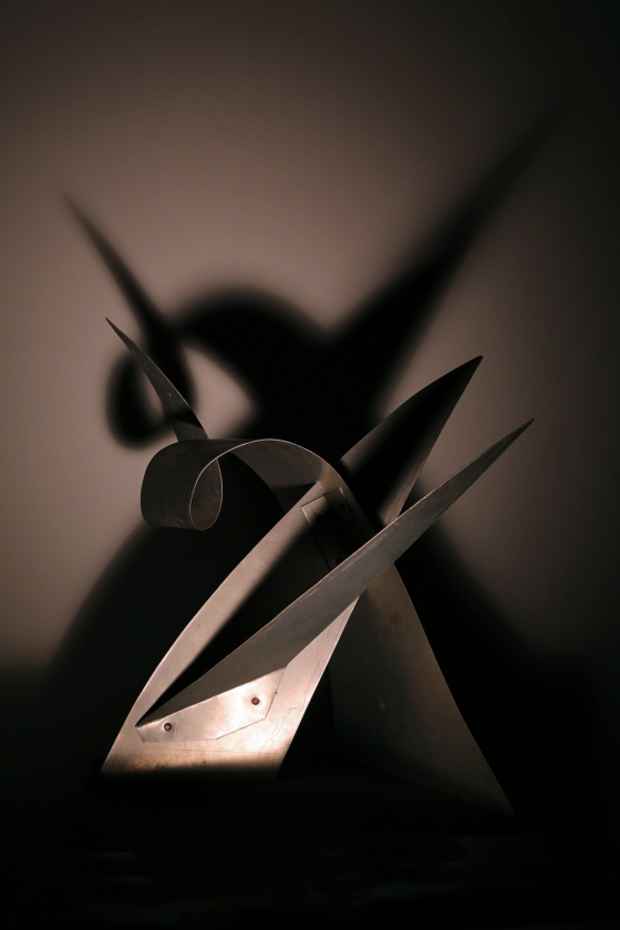“Calder Shadows” Exhibition
Venus over Manhattan

This event has ended.
Sculptor, painter, illustrator, printmaker and designer, the renowned American artist Alexander Calder (1898 – 1976) was above all a master engineer of shifting lines and dancing shadows. After visiting Piet Mondrian’s studio in 1930, Calder began the experiments with abstract construction that would come to define his oeuvre. He drew inspiration from the playful work of Joan Miró and Paul Klee, and adopted the intuitive approach of the Surrealists, making hand- cranked and motorized kinetic sculptures that challenged the definition of sculpture as a form fixed in space and created a place for motion in the expressive vocabulary of art. Calder’s mechanized works gave way to his mobiles and stabiles, sculptures whose disparate metal elements – made from bent wire and flat sheet metal cut-outs - were constructed with such masterful equipoise that their movements occurred naturally and unpredictably in response to the energy of the surrounding atmosphere. “How can art be realized?” Calder asked. “Out of volumes, motion, spaces bounded by the great space, the universe…Not extractions, but abstractions. Abstractions that are like nothing in life except in their manner of reacting.”
Beginning November 4, 2013, Venus Over Manhattan will present Calder Shadows, an exhibition designed uniquely to explore the exquisite “manner of reacting” that sets the artist’s work apart: A group of a dozen rare Calder mobiles and stabiles created between 1929 and 1974 will be presented in darkness. Each sculpture will be lit so that its shadows become the exhibition’s subject: wire will become oscillating line drawings and flat metal forms will become independent presences that dance along the walls, ceiling, and floor of the gallery. Calder Shadows will also present a group of the artist’s small maquettes in unpainted sheet metal executed in the years between 1966 and 1974. Calder used of shadows cast by such maquettes to explore issues of of scale as he formulated his monumental stabiles.
Organized in collaboration with the Calder Foundation, Calder Shadows will remain on view through December 21, 2013.
Among the masterpieces on view at Venus will be Little Black Flower (1944), an exemplary mobile created during the decade widely considered to be the most fertile period of development in the artist’s career. Privately held and not exhibited since the 1940s, the sculpture is composed of red-painted metal and wire, with a small black flower dancing at the end of a wire ‘stem.’ Also on view will be a 1939 mobile from Calder’s ‘Tuning Fork: series, a work that suggests the artist’s affinity with the Surrealists.
Among stabiles on view will be examples from the mid-1930s and The New Ritou (1948), a stabile in which Calder revisited and perfected a 1936 sculpture titled Ritou, made of sheet metal, wire string, and paint. The later stabile Ringmaster, created in 1967, relates to the theme of the circus, a subject that fascinated Calder throughout his life: As a student in New York in the mid-1920s, Calder worked for the National Police Gazette newspaper and was assigned to sketch the Ringling Brothers and Barnum & Bailey Circus. One of the artist’s most enduringly beloved works, first fashioned in 1926, is his Cirque Calder, a miniature circus made from wire, string, rubber, cloth and found materials, which today resides in the Whitney Museum of American Art in New York.
Alexander Calder was born in Philadelphia, Pennsylvania in 1898, and died in New York City in 1976. He studied at the Stevens Instituted of Technology in Hoboken, New Jersey, and the Art Students League in New York, moving to Paris in 1926 and settling in the early 1960s in Indre-et- Loire, France. Calder’s first public commission was given to the artist in the 1930s by the Berkshire Museum in Pittsfield, Massachusetts. Today his work can be seen in prestigious museum collections worldwide, including those of The Museum of Modern Art, New York; The Whitney Museum, New York; the Centre Georges Pompidou, Paris; and the National Gallery of Art, Washington, D.C.
Calder’s work has been presented in scores of museum exhibitions. Among the most notable of the recent exhibitions have been “Calder: Gravity and Grace” at the Solomon R. Guggenheim Museum (2003); “The Surreal Calder” at The Menil Collection, Houston (2005-6); “Alexander Calder: The Paris Years, 1926–1933” at the Whitney Museum of American Art, New York (2008-9); “Calder’s Portraits: A New Language” at the National Portrait Gallery, Washington, D.C. (2011); and “Calder,” Leeum, Samsung Museum of Art, Seoul (2013). The exhibition “Calder Gallery II” can be seen at the Fondation Beyeler, Riehen, Switzerland through June 2014.
Media
Schedule
from November 04, 2013 to February 01, 2014
Opening Reception on 2013-11-04 from 18:00 to 20:00